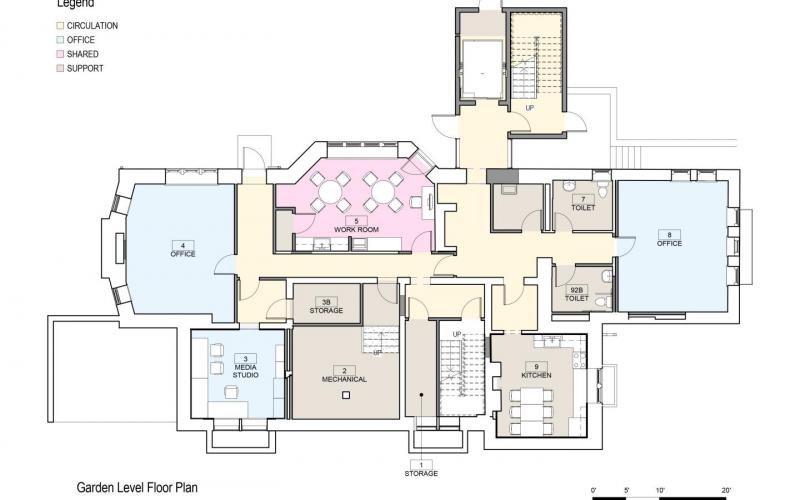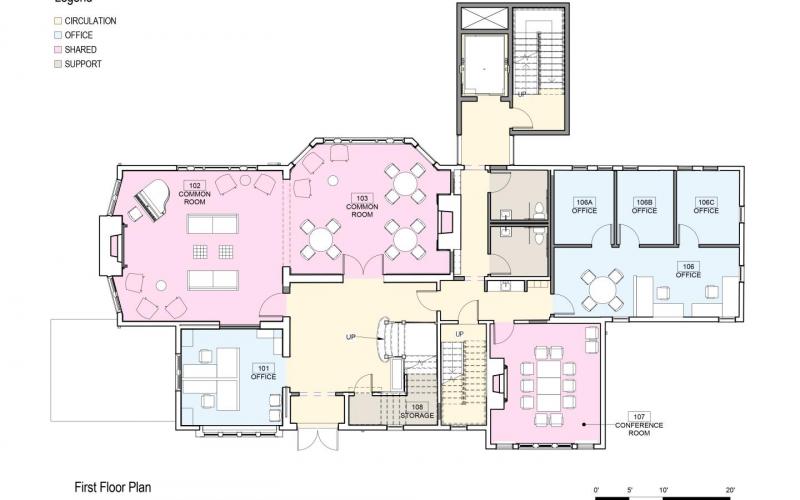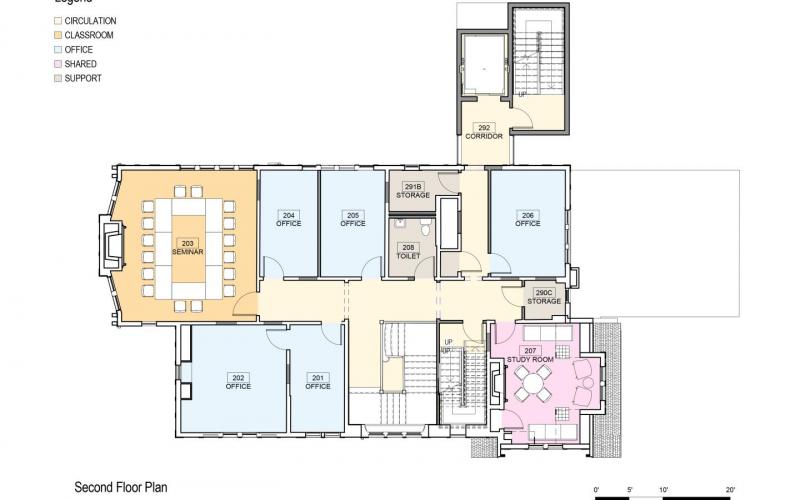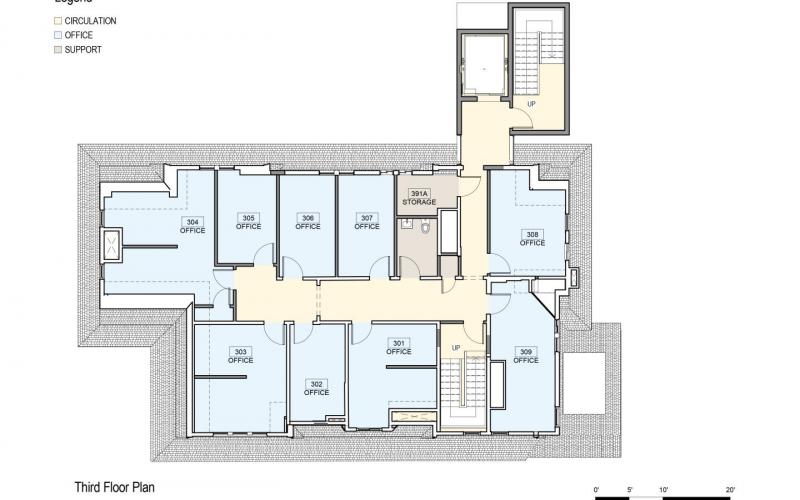From the Director’s Desk
Martin Jean
Space Update
Since we announced the renovation of 406 Prospect Street last fall, we have been hard at work in planning with Yale Facilities and with our architects, Apicella + Bunton. I am happy to share with you the draft of our proposed floor plans which are now out for construction bids. Allow me to be your tour guide.
[photo of 406 Prospect by Tyler Gathro]
In keeping with Yale’s philosophy to preserve, where possible, the original character of its historic structures, many of the features 406 Prospect Street’s original identity as a stately private home will be retained. Built in Tudor-revival style by the architect Grosvenor Atterbury, over the decades the property was successively a home for the Day and Twitchell families before being acquired by Dwight Hall at Yale and converted to apartments for several generations of international students. The International Student Center at Yale celebrated America’s commitment to opening itself and its institutions to create a diverse community for brilliant young scholars from around the world. This global spirit will inform the Institute’s programmatic work in this space as well.
The renovated design of 406 Prospect Street is shaped by the desire to bring together the many elements of the ISM’s work across lines of religious tradition, artistic practice, scholarly methodology and style, and geography. The main floor will keep much of its period charm, from the open entranceway and staircase, to the spacious dining room and living room which lie just beyond. These two rooms will be joined by opening up the pocket door that currently divides them, thus transforming the space into a common room suitable for quiet study and conversation or, with minor rearrangement of furniture, to an event space for 60 or more people. We expect to fit it out with musical instruments and audio-visual equipment to support performance and teaching alike. Here, and throughout the building, special lighting will allow us to curate small art exhibitions for our students and guests.
Staff offices are positioned just inside the front door to provide security and support for visitors and residents. The room just to the north of the stair, likely a study or library originally, will now function primarily as a conference room or seminar space. A staff office suite will replace what has been the kitchen.
Downstairs, the lower level opens up to the back garden and incorporates the most design flexibility. In addition to the new catering kitchen installed on the north end and an audio-visual studio on the south, there will be student workrooms and spaces for group projects and meetings. This floor also has potential to accommodate growth in faculty and staff.
On the second floor, you can see a state-of-the-art teaching space for classes of about 25 featured as well as a smaller room for quiet study or conversation. This floor has offices for staff, faculty, and director as well.
The roomy third floor will house offices for faculty and fellows. From up here, the high elevation of the house offers beautiful views of the Divinity Quadrangle and Betts house on the one side and West Rock on the other.
This new home for the Institute means a great deal to our community. On the one hand, it is the realization of a dream begun by my predecessor, Margot Fassler, who already predicted we would outgrow our current premises in the SDQ. On the other hand, 406 Prospect is a valuable tool the Institute will use to grow even more into its broad, generous, and interdisciplinary mission. None of our various fields lives in isolation, but rather, each strives to shed light on the others. This new space provides, in a sense, a structure to promote our synergy and collaboration.
New Initiatives
As we deepen our commitment to our own mission, we seek to enhance work in the many academic units at Yale whose missions intersect ours. By partnering with them to develop new programs, we also bring this work to new audiences and create new synergies.
We are currently in conversation with a number of departments to sponsor joint faculty appointments and multi-year post-docs. Simultaneously, we are also looking at flexible platforms through which new work and innovation can be featured continually.
Promoting Interdisciplinary Scholarship in Yale’s Collections
As a first step, we are launching a short-term fellows program (in addition to our existing semester-long and yearlong fellows program) in conjunction with several of Yale’s major collections. The 2011 reopening of Yale Art Gallery, for example, with its 40,000 square feet of new and newly renovated exhibition space, attracted worldwide attention. Less well known is the fact that there is room there to display less than 5% of the Gallery’s holdings. Many of these massive collections – at the Art Gallery, the Yale Center for British Art, the Beinecke Rare Book & Manuscript Library, and at the Yale Peabody Museum of Natural History – have yet to be fully studied, and many subsets of them come directly from religious cultures of every kind. With this new fellowship program, the ISM will support new and ongoing research by inviting visiting scholars – from graduate students to senior faculty – to Yale to study these objects and artifacts.
A case in point is the Dura Europos collection, which continues to be a focal point for Yale. Particularly since the original site in eastern Syria has been in constant danger of destruction, Yale has become the epicenter of research into this important ancient multi-culture community. Since a great deal of this material is related to religious practice, the ISM hopes to become a prominent partner in its continued study.
Promoting Pedagogy in Global Cultural Contexts
The Institute has been fortunate to welcome to campus musicians and artists from all over the world who wish to share elements of their rich devotional practices. We hope and expect this to continue. As valuable as these encounters may be, they are, by definition, divorced from their natural contexts. The Institute has sponsored a number of graduate seminars which reverse this process by bringing graduate and upper level undergraduate students to the sites in question. Last spring, for example, twelve students traveled to Serbia, Kosovo, and Macedonia to study Byzantine churches and monasteries (see student reflection here). This year, students are engaging with the roots of the Sarum rite in England (student reflection coming soon). Building on these successes, and as another way of forging University partnerships, we are sending out a campus-wide call for proposals for team-taught, interdisciplinary graduate seminars in sacred music, worship, and the arts with a travel component, which the ISM will sponsor. This expanded undertaking will bring potentially life-changing travel/study experiences to brilliant young scholars and artists from all over the university.
These, and the initiatives already outlined in the fall 2016 issue, are some of the directions we have been considering. We remain grateful for your prayers and open to your ideas as to how the work of the ISM can be directed most effectively to address the many needs we face today. Our commitment to cross-disciplinary collaboration is more vital than ever, and we give thanks for the opportunities that lie ahead.



